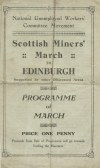| Glasgow Digital Library | RED CLYDESIDE | PEOPLE | EVENTS | GROUPS | LITERATURE | INDEX |
|---|
The 1920s and 1930s were the classic example of capitalism in crisis. Unemployment reached colossal levels in the advanced capitalist countries, and whole industries were laid waste as the peculiar affliction of over-production left its scars. After the first world aar ended in 1918 it was assumed in Britain that the recession which followed closely behind was merely the result of a post-war upset in the economy. Production and trade, which fell during the 1920s, were expected to pick up again as they resumed their normal peace-time rhythm.

The crash which began in Wall Street in 1929 soon shattered any illusions which may have existed about the prospect of a smooth transition to a boom economy. The slump spread its effects worldwide, and the British economy, which had been sliding gradually into recession anyway, foundered along with the rest. By August 1931 unemployment had reached 2.7 million, and 20% of this jobless army had been out of work for over six months. By 1933 this tragic figure had risen to very nearly three million, which represented a record 23% of the insured workforce.

The National Unemployed Workers Movement was formed in 1921 out of the demobilised sailors' and soldiers' associations, primarily to organise the unemployed and agitate for 'work or full maintenance'. The NUWM was dominated by members of the Communist Party and was active on a host of issues including rent strikes, campaigns against evictions, campaigns against labour camps, and a high-profile campaign against the means test. The first campaign of the NUWM was against the 'task work' system whereby those claiming outdoor (i.e. non-workhouse) relief had to work for their benefits. At the height of the depression years around 10% of Britain's unemployed were involved in the NUWM and around one million people passed through its ranks.

Dominated as it was by members of the Communist Party , the NUWM saw itself as part of the labour movement and as such it sought to put forward respectable social democratic demands. Yet the leadership of the official labour movement refused to accept the NUWM. Thus although the NUWM was autonomous of the TUC, and committed to tactics of direct action, this was not through choice but because the latter rejected them. Indeed, it could be said that the NUWM was forced to become radical despite its social democratic orientation.

The movement is famous now for its more spectacular forms, such as the national hunger marches. These mass marches were seen as a threat to public order, and were the occasion of often violent confrontations with the police. In the 1920s, this kind of threat forced the government to extend the unemployment insurance system. In 1932, a mass march from different towns across the UK, converging on London, ended in a riot with the police in Hyde Park. Such events forced the government into a hasty climb-down on part II of the proposed unemployment bill, under which benefits were to be slashed and claimants to undergo compulsory 'training' and work-for-dole in 'social service centres'.
Despite the movement's national profile, most of the NUWMs successes were in the form of local agitations which forced concessions from the locally-administered relief system. Many of these local activities, too, entailed battles with the police, particularly in London, where the movement was strongest. The NUWM also gave active support to workers on strike, in order to maintain the price of labour-power.
| Glasgow Digital Library | RED CLYDESIDE | PEOPLE | EVENTS | GROUPS | LITERATURE | INDEX |
|---|